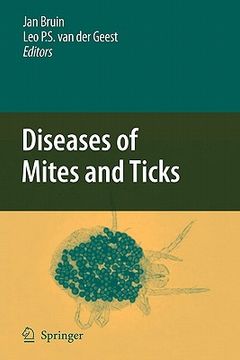Share
diseases of mites and ticks
Jan Bruin
(Illustrated by)
·
Leo Van Der Geest
(Illustrated by)
·
Springer
· Paperback
diseases of mites and ticks - Bruin, Jan ; Van Der Geest, Leo
Choose the list to add your product or create one New List
✓ Product added successfully to the Wishlist.
Go to My Wishlists
Origin: U.S.A.
(Import costs included in the price)
It will be shipped from our warehouse between
Monday, July 01 and
Thursday, July 11.
You will receive it anywhere in United Kingdom between 1 and 3 business days after shipment.
Synopsis "diseases of mites and ticks"
Ticks transmit a greater variety of pathogens than any other group of hemotophagous arthropods (Sonenshine 1993). In ticks, the midgut is the ?rst site of exposure to a wide variety of hemoparasites that may be ingested with the bloodmeal. Some of these he- parasites are either not infective for ticks and rapidly digested or cleared by the innate tick immune system. Others infect midgut epithelial cells where they multiply and subsequently infect other tissues including the salivary glands. Transmission may occur when the tick is ingested by the vertebrate host or from salivary glands via the saliva to vertebrate hosts when the tick feeds again. Tick-borne pathogens have apparently co-evolved with ticks for their mutual survival because, while pathogens undergo considerable multiplication in ticks, these infections do not appear to be detrimental to tick feeding or their biology (Kocan et al. 1992a, 2005; Sonenshine et al. 2005). Among the various tick-borne pathogens, those belonging to the genus Anaplasma (Rickettsiales: Anaplasmataceae) are obligate intracellular organisms found exclusively within parasitophorous vacuoles in the cytoplasm of both vertebrate and tick host cells (Kocan 1986; Dumler et al. 2001). The type species, A. marginale, causes the econo- cally important cattle disease, anaplasmosis, with Dermacentor variabilis comprising one of the main tick vectors of this pathogen in the USA (Kocan et al. 2004).
- 0% (0)
- 0% (0)
- 0% (0)
- 0% (0)
- 0% (0)
All books in our catalog are Original.
The book is written in English.
The binding of this edition is Paperback.
✓ Producto agregado correctamente al carro, Ir a Pagar.

